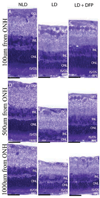Systemic administration of the iron chelator deferiprone protects against light-induced photoreceptor degeneration in the mouse retina
- PMID: 22579919
- PMCID: PMC3380452
- DOI: 10.1016/j.freeradbiomed.2012.04.020
Systemic administration of the iron chelator deferiprone protects against light-induced photoreceptor degeneration in the mouse retina
Abstract
Oxidative stress plays a key role in a light-damage (LD) model of retinal degeneration as well as in age-related macular degeneration (AMD). Since iron can promote oxidative stress, the iron chelator deferiprone (DFP) was tested for protection against light-induced retinal degeneration. To accomplish this, A/J mice were treated with or without oral DFP and then were placed in constant bright white fluorescent light (10,000 lx) for 20 h. Retinas were evaluated at several time points after light exposure. Photoreceptor apoptosis was assessed using the TUNEL assay. Retinal degeneration was assessed by histology 10 days after exposure to damaging white light. Two genes upregulated by oxidative stress, heme oxygenase 1 (Hmox1) and ceruloplasmin (Cp), as well as complement component 3 (C3) were quantified by RT-qPCR. Cryosections were immunolabeled for an oxidative stress marker (nitrotyrosine), a microglial marker (Iba1), as well as both heavy (H) and light (L) ferritin. Light exposure resulted in substantial photoreceptor-specific cell death. Dosing with DFP protected photoreceptors, decreasing the numbers of TUNEL-positive photoreceptors and increasing the number of surviving photoreceptors. The retinal mRNA levels of oxidative stress-related genes and C3 were upregulated following light exposure and diminished by DFP treatment. Immunostaining for nitrotyrosine indicated that DFP reduced the nitrative stress caused by light exposure. Robust H/L-ferritin-containing microglial activation and migration to the outer retina occurred after light exposure and DFP treatment reduced microglial invasion. DFP is protective against light-induced retinal degeneration and has the potential to diminish oxidative stress in the retina.
Copyright © 2012 Elsevier Inc. All rights reserved.
Conflict of interest statement
Figures







References
Publication types
MeSH terms
Substances
Grants and funding
LinkOut - more resources
Full Text Sources
Other Literature Sources
Research Materials
Miscellaneous

